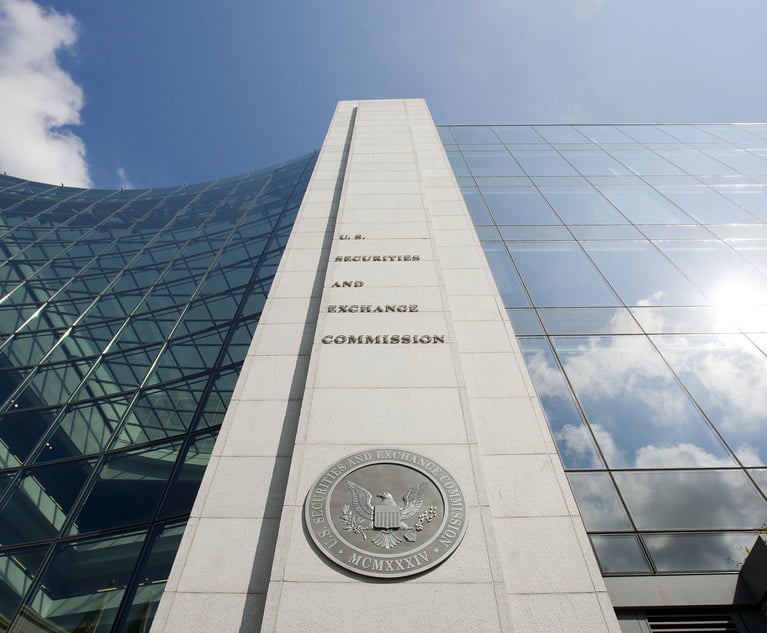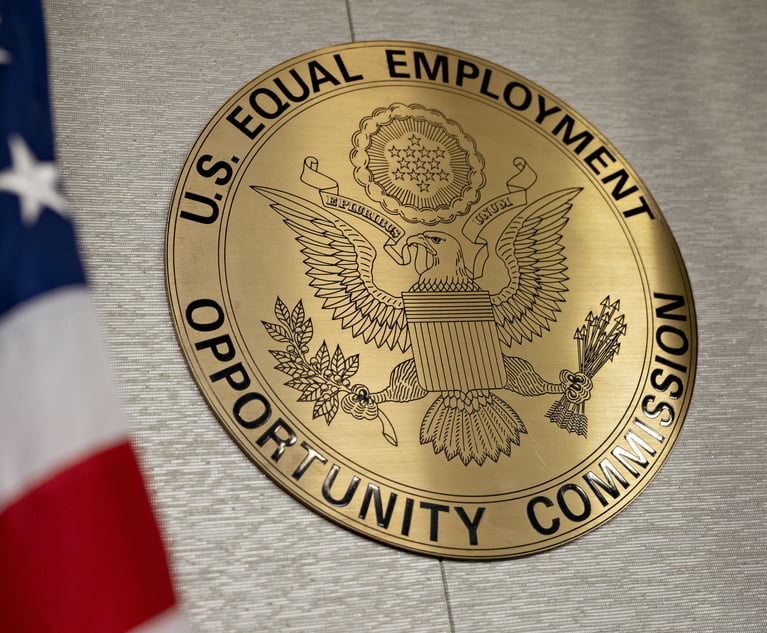Lack of legislation and a surplus of case law are changing class action lawsuits
Defendants need to keep an eye on developments coming from individual cases and state legal changes to properly defend themselves from the risk of class action lawsuits.
March 24, 2014 at 08:00 PM
7 minute read
For corporations, the threat of class action lawsuits is a cumbersome and expensive legal challenge that can sap budgets at a moment's notice. Though some industries are more susceptible than others, there is no sector impervious to actions brought on by a large group of defendants. The vast array of class action types—from wage and hour to consumer goods to securities—means that the risk of class action is omnipresent.
The argument that class action lawsuits are frivolous and overly burdensome for defendants is nothing new, but while cases brought against businesses are a common occurrence, legislative changes that would help to reduce the volume of cases, settlement figures or the number of plaintiffs have been few and far between in recent years. Those attempts to limit a plaintiff's right to sue have made civil justice reform a loaded term and are seeing considerable push back whenever such changes are proposed, according to James Jorden, shareholder of Carlton Fields Jorden Burt law firm.
“Civil justice reform is probably in the proverbial eye of the beholder,” Jorden explains. “To some it may mean a broadside attack on the entire system of civil trials and procedures (and laws). To most practitioners, particularly trial lawyers, it means a continuing effort to review and improve the rules of civil procedure to better accommodate the resolution of disputes in our judicial system and, in particular, to make them more efficient and less expensive.” Attempts to change the way that civil proceedings happen in favor of corporate defendants have lost traction, meaning that defendants need to keep an eye on developments coming from individual cases and state legal changes to properly defend themselves from the risk of class action lawsuits.
“In candor, this is a war we are not winning,” Jorden says.
Don't hold your breath
Legislation like the Civil Just Reform Act (CJRA) and the Class Action Fairness Act (CAFA) are evidence that paradigm shifting legislation is possible. However, corporations hoping that another wave of legislative reform will help the current volume of class action suits are likely to be disappointed by recent developments.
“From a nationwide perspective, congressionally things are somewhat silent. CAFA is not that old— it's been out there for nine years— but we're still seeing that only now it's making its way up to the Supreme Court on certain issues. So from that perspective, Congress may think it's not yet time to go back to the well on class action reform,” explains Rob Wise, partner at Bowman and Brooke LLP. “There's also probably rightly a perception that this may not be the right administration to try to take on class action or litigation reform.”
In addition to an absence of federal legislative activity, organizations are subject to risk from increasingly complicated regulation, court rules at the state level and the interpretation of case law by plaintiffs' lawyers.
In California, for example, consumer protection laws and increasing legislation make class action lawsuits against consumer goods, food and cosmetics companies easier, often making it the venue of choice for state class action lawsuits.
“Given the current composition of the California Legislature—where most of the class actions are brought—there's not a lot of legislative reform that you see on the horizon,” says David Biderman, partner at Perkins Coie LLP. “In fact, it seems like it's going in the other direction.”
And Biderman says that even when complying with federal regulatory agencies' requests, the risk of class action lawsuits still exists in other forms. Say, for example, your food product complies with Food and Drug Administration standards, protecting you from certain lawsuits. That doesn't mean the plaintiffs' bar will seek to file class action complaints for other unrelated reasons.
This raises the question: Even with the considerable lack of class action reform stemming from a federal level, would potential civil justice reform discourage the plaintiffs' bar from finding ways to sue anyway?
“We see already, even with the current class action reform legislation, attempts to get around some of the positive improvements that have been made in the class action system, such as through CAFA,” Wise says. “For example, we routinely see attempts to get around CAFA's provision for federal jurisdiction for 100-plaintiff mass-action, by doing things like splitting cases up into batches of 70, 80, or 90 plaintiffs, even though they are identical cases, or attempts to stipulate to less than the $5 million jurisdictional amount to try to prevent CAFA removal, which the Supreme Court rejected in Standard Fire v. Knowles.” But even if some major changes were to break the stagnation of current reform efforts, chances are the plaintiffs' bar would find a creative way around them.
Case by case
Regardless of their industry of genesis, court decisions can have wide-ranging effects on the way that lawsuits are brought to defendants. Comcast v. Behrend, for example found that a class was improperly certified under Federal Rule of Civil Procedure 23(b)(3), and had impacted the concept of predominance, requiring classes to offer more information about damages before allowing a case to proceed.
“We've been watching very closely how the district courts are interpreting it and whether or not district courts are requiring them to put forth a damages model, or whether they say that can be done later. I think the Comcast decision continues to develop and be interpreted, and my hunch is that at some point another appelate court is going to have to have some say on it,” explains Sascha Henry, a partner with Sheppard Mullin Richter and Hampton LLP.
A similar situation is currently playing out in Halliburton Co. v. Erica P. John Fund, Inc., which could have major implications on how and when plaintiffs need to show they relied on material statements when making investment decisions. If, as a result of the Halliburton case, securities plaintiffs can no longer rely on the presumption that alleged misinformation about a company inflated a stock price, then likewise a consumer may not be able to rely on a presumption that a problem with a product makes it worthless.
Decisions like that can quickly and dramatically change the standards of court procedure, and once they've been made, offer new avenues for interpretations that could be beneficial for either plaintiffs or defendants.
What to do
With no legislative relief pending, and with court rulings that can quickly and dramatically change the way that class action lawsuits operate a constant risk, what should legal teams be doing in the face of potential class action lawsuits?
“They need to look for opportunities to help shape the law; there are a lot of issues that haven't been hashed out but that need to be. So, looking for cases where there are arguments to raise, and getting them up for appellate review will be critical,” Wise advises.
Because of the wide-ranging implications that a class action suit can have on operations, pulling in representative members of the organization can be essential to the mitigation of lawsuit.
“Put the resources in the initial investigation of the case, and look at it from a business perspective.Then come up with strategies to deal with litigation, whether that be through settlement or fighting it,” Henry says. Regardless of the type of class action lawsuits that a corporation can expect, keeping abreast of potential legislation at both the state and federal level, as well as decisions coming out of prominent cases, should help prepare companies for the worst.
This content has been archived. It is available through our partners, LexisNexis® and Bloomberg Law.
To view this content, please continue to their sites.
Not a Lexis Subscriber?
Subscribe Now
Not a Bloomberg Law Subscriber?
Subscribe Now
NOT FOR REPRINT
© 2025 ALM Global, LLC, All Rights Reserved. Request academic re-use from www.copyright.com. All other uses, submit a request to [email protected]. For more information visit Asset & Logo Licensing.
You Might Like
View All

‘Extremely Disturbing’: AI Firms Face Class Action by ‘Taskers’ Exposed to Traumatic Content
5 minute read
In-House Lawyers Are Focused on Employment and Cybersecurity Disputes, But Looking Out for Conflict Over AI
Trending Stories
- 1A Primer on Using Third-Party Depositions To Prove Your Case at Trial
- 2‘Catholic Charities v. Wisconsin Labor and Industry Review Commission’: Another Consequence of 'Hobby Lobby'?
- 3With DEI Rollbacks, Employment Lawyers See Potential For Targeting Corporate Commitment to Equality
- 4In-House Legal Network The L Suite Acquires Legal E-Learning Platform Luminate+
- 5In Police Shooting Case, Kavanaugh Bleeds Blue and Jackson ‘Very Very Confused’
Who Got The Work
J. Brugh Lower of Gibbons has entered an appearance for industrial equipment supplier Devco Corporation in a pending trademark infringement lawsuit. The suit, accusing the defendant of selling knock-off Graco products, was filed Dec. 18 in New Jersey District Court by Rivkin Radler on behalf of Graco Inc. and Graco Minnesota. The case, assigned to U.S. District Judge Zahid N. Quraishi, is 3:24-cv-11294, Graco Inc. et al v. Devco Corporation.
Who Got The Work
Rebecca Maller-Stein and Kent A. Yalowitz of Arnold & Porter Kaye Scholer have entered their appearances for Hanaco Venture Capital and its executives, Lior Prosor and David Frankel, in a pending securities lawsuit. The action, filed on Dec. 24 in New York Southern District Court by Zell, Aron & Co. on behalf of Goldeneye Advisors, accuses the defendants of negligently and fraudulently managing the plaintiff's $1 million investment. The case, assigned to U.S. District Judge Vernon S. Broderick, is 1:24-cv-09918, Goldeneye Advisors, LLC v. Hanaco Venture Capital, Ltd. et al.
Who Got The Work
Attorneys from A&O Shearman has stepped in as defense counsel for Toronto-Dominion Bank and other defendants in a pending securities class action. The suit, filed Dec. 11 in New York Southern District Court by Bleichmar Fonti & Auld, accuses the defendants of concealing the bank's 'pervasive' deficiencies in regards to its compliance with the Bank Secrecy Act and the quality of its anti-money laundering controls. The case, assigned to U.S. District Judge Arun Subramanian, is 1:24-cv-09445, Gonzalez v. The Toronto-Dominion Bank et al.
Who Got The Work
Crown Castle International, a Pennsylvania company providing shared communications infrastructure, has turned to Luke D. Wolf of Gordon Rees Scully Mansukhani to fend off a pending breach-of-contract lawsuit. The court action, filed Nov. 25 in Michigan Eastern District Court by Hooper Hathaway PC on behalf of The Town Residences LLC, accuses Crown Castle of failing to transfer approximately $30,000 in utility payments from T-Mobile in breach of a roof-top lease and assignment agreement. The case, assigned to U.S. District Judge Susan K. Declercq, is 2:24-cv-13131, The Town Residences LLC v. T-Mobile US, Inc. et al.
Who Got The Work
Wilfred P. Coronato and Daniel M. Schwartz of McCarter & English have stepped in as defense counsel to Electrolux Home Products Inc. in a pending product liability lawsuit. The court action, filed Nov. 26 in New York Eastern District Court by Poulos Lopiccolo PC and Nagel Rice LLP on behalf of David Stern, alleges that the defendant's refrigerators’ drawers and shelving repeatedly break and fall apart within months after purchase. The case, assigned to U.S. District Judge Joan M. Azrack, is 2:24-cv-08204, Stern v. Electrolux Home Products, Inc.
Featured Firms
Law Offices of Gary Martin Hays & Associates, P.C.
(470) 294-1674
Law Offices of Mark E. Salomone
(857) 444-6468
Smith & Hassler
(713) 739-1250







